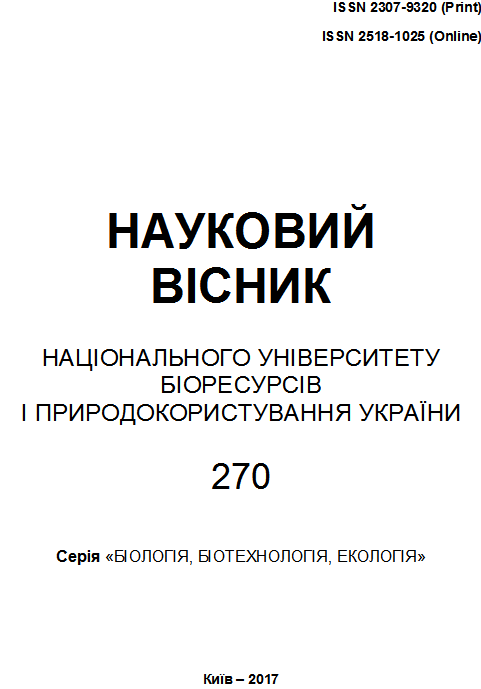PATHOGENICITY OF SOIL-BORNE FUNGI – CAUSAL AGENTS OF WHEAT ROOT DISEASES
Abstract
Breeding of wheat cultivar resistant against root diseases is a difficult problem because the lack of evidence about nature of pathogenicity of soil-borne fungi –causal agents of these diseases and their interaction with host plant.
The aim of this research was to investigate the character of pathogenicity of Bipolaris sorokiniana, Fusarium spp. и Oculimacula spp. – causal agents of common root rot, Fusarium root rot and eyespot on wheat seedlings under the artificial inoculation with isolates B. sorokiniana, F. oxysporum, F. culmorum, O. acuformis and O. yallundae. It has been revealed that there is significant difference between isolates B. sorokiniana, F. culmorum and F. oxysporum in pathogenicity, which was confirmed by the assessment of root rot severity on inoculated seedlings. Under the artificial inoculation of wheat seedlings with isolates O. acuformis and O. yallundae the severity of eyespot depends significantly on wheat cultivar characteristics. Based on results of our experiments we also suggested the virulence characteristic in B. sorokiniana isolates.
Thus, it has been confirmed the specificity of interaction the soil-borne fungi with plant host in every particular pathosystem, that should be considered in breeding programs for resistance against root and stem-base diseases.
References
Akulov O.Yu. (2007). Biologichni osoblyvostci Bipolaris sorokiniana (Sacc. in Sorokin) i diagnostika zbudnykiv korenevoyi gnyli ta chornogo zarodku yarogo yachmeniu [Biological features of Bipolaris sorokiniana (Sacc. in Sorokin) Shoemaker and diagnostics of infecting agent of root rot and black point of seeds]. National Agrarian University, Kyiv. – 21 s.
Djakov, Yu.T. (1996). Pyatdesyat let teorii «gen-na-gen» [Fifty years of gen-for-gen theory]. Achievements of modern biology, 116 (3), 293-305.
Kovalyshyna H.M. (2014). Stijkist sortiv pshenytсi ozymoji proty khvorob [Resistance wheat cultivars against diseases]. Protection and quarantine of plant, 60, 151-158.
Kriuchkova L.O. (2016). Korenevi i prykorenevi khvoroby pshenytzi [Root and stem-base diseases of wheat]. NULESU, 164 s.
Lisovyi M.P., Lisova H.M., Afansjeva O.G., Boiko I.A., Dovgal Z.M. (2013). Kharakterystika kolektzijnogo materialu pshenytzi ozymoji za stijkistju proty khvorob [Characteristic of collection material of winter wheat for resistance against diseases]. Protection and quarantine of plant, 59, 176 -184.
Rozhkova T.O. (2004). Struktura populyatzij zbudnykiv temno-buroji ta sitchastoji pljamystostei lystya yachmenju yarogo u pivnichno-skhidnomu Lisostepu ta poshuk dzherel stijkostyi [ Population structure of causal agents of spot blotch and net spot of spring barley in northern-eastern Forest-Steppe and search of resistance sources]. National Agrarian University, Kyiv. - 21 s.
Alves-Santos F.M., Cordeiro-Rodrigues L., Sayagues J.M., Martin-Dominguez R., Garcia-Benavides P., Crespo M.C., Diaz-Minguez J.M., Eslava A.P. (2002). Pathogenicity and race characterization of Fusarium oxysporum f.sp. phaseoli isolates from Spain and Greece. Plant Pathology, 51, 605 – 611.
Dangl J.L., Horvath D.M., Staskawicz B.J. (2013). Pivoting the Plant Immune System from Dissection to Deployment. Science, August 16; 341(6147). doi:10.1126/science.1236011.
de Haan L.A.M., Numansen A., Roebroeck E.J.A., van Doorn J. (2000). PCR detection of Fusarium oxysporum f.sp. gladioli race 1, causal agent of Gladiolus yellows diseases, from infected corms. Plant Pathology, 49, 89 – 100.
Miedaner D., Korzun V. (2012). Marker-Assisted Selection for Disease Resistance in Wheat and Barley Breeding. Phytopathology, 102, 560-566.
Downloads
Published
Issue
Section
License
Relationship between right holders and users shall be governed by the terms of the license Creative Commons Attribution – non-commercial – Distribution On Same Conditions 4.0 international (CC BY-NC-SA 4.0):https://creativecommons.org/licenses/by-nc-sa/4.0/deed.uk
Authors who publish with this journal agree to the following terms:
- Authors retain copyright and grant the journal right of first publication with the work simultaneously licensed under a Creative Commons Attribution License that allows others to share the work with an acknowledgement of the work's authorship and initial publication in this journal.
- Authors are able to enter into separate, additional contractual arrangements for the non-exclusive distribution of the journal's published version of the work (e.g., post it to an institutional repository or publish it in a book), with an acknowledgement of its initial publication in this journal.
- Authors are permitted and encouraged to post their work online (e.g., in institutional repositories or on their website) prior to and during the submission process, as it can lead to productive exchanges, as well as earlier and greater citation of published work (See The Effect of Open Access).

